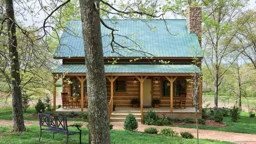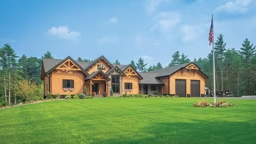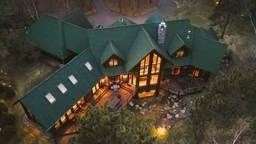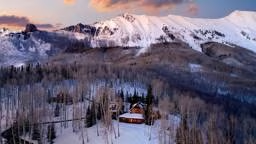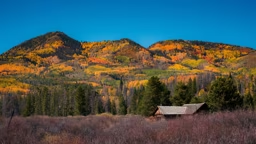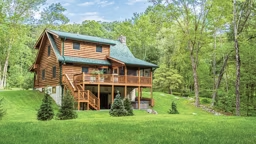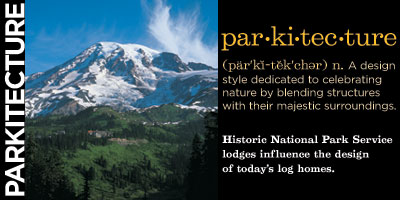
More than a century ago, 29-year-old architect Robert Reamer designed a lodge for what would become our nation's first national park in Yellowstone, Wyoming. Siting it near the famous geyser, Old Faithful, the 1904 building made of logs and stones also made history: The Old Faithful Inn became the first great lodge of the West.
Today, visitors who enter the inn and stand beneath its massive gabled roof are awed by ceilings that soar 85 feet into the air. Its 40-foot-tall fireplace--made from 500 tons of lava rock--anchors a hall of log columns, gnarled railings and split-log staircases.
"It was the original inspiration for what would become the National Park Service Design of rustic architecture or what's now called 'parkitecture,' " says Lee Whittlesey, a NPS historian who gives tours of the inn and the park.
"The Old Faithful Inn reflects the same philosophy espoused by the Arts-and-Crafts movement being embraced at that time in America," says Christine Barnes, in her book Great Lodges of the West. "Simplicity, use of native handwork and blending of the building with the site are the movement's fundamental principles."
By using local materials, such as hewn logs, timbers and stone to blend the building with its natural surroundings, Reamer's design paved the way for the aesthetic made famous by our National Park lodges. In addition to the Old Faithful Inn, some examples include the Paradise Inn at Mt. Rainier National Park in Washington State and the Grand Canyon Lodge in Arizona.
Today, the Old Faithful Inn is more popular than ever, attracting three million visitors each year. The first stop? The lodge's three-story-tall great hall. "You can always spot the visitors," says Lee. "They're the ones looking up."
Parkitecture Today
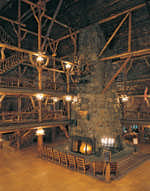 Modern parkitecture is most notably defined by its use of over-scaled materials, including log, stone, timber, glass and hand-forged steel, according to Allen Halcomb of MossCreek Designs in Knoxville, Tennessee, which partners with Meridian, Idaho-based PrecisionCraft Log and Timber Homes and Tennessee Log Homes out of Athens.
Modern parkitecture is most notably defined by its use of over-scaled materials, including log, stone, timber, glass and hand-forged steel, according to Allen Halcomb of MossCreek Designs in Knoxville, Tennessee, which partners with Meridian, Idaho-based PrecisionCraft Log and Timber Homes and Tennessee Log Homes out of Athens.The desired result is to create structures that appear "to have grown right from their earthy pedestal," he says. "Brawny, expressive and sometimes clunky, these structures appear as a form of nature that has been tamed by man. Experiencing one of these structures helps you understand that man is but only one part of the natural landscape."
Architect Ellis Nunn of Jackson Hole, Wyoming, says his log home clients often ask for design elements they've seen at either Old Faithful Inn or Timberline Lodge in Mt. Hood, Oregon. Ellis' favorite work in the style of the National Park lodge is by architect Gilbert Stanley Underwood, who designed the Grand Canyon Lodge and the Ahwahnee Lodge in Yosemite National Park and who acted as the consulting architect for Timberline Lodge. These traits can be easily recognized in many of Ellis' designs.
Bringing Parkitecture Home
For someone seeking to give their home that parkitecture feel, Ellis likes to incorporate dormer windows and a large log and stone porte-cochere into the design. It gives a home "a great lodge look," he says. An added bonus, he says: "With all the new building materials, you have the ability to make almost anything new look old."That sentiment is echoed by John Johnson, owner of Sitka Log Homes in 100 Mile House, British Columbia, Canada, who says today's log home design has taken the natural look of the parkitecture style and improved on it. How? By upping it to a refined art--adding elements such as flared cedar posts that previously were considered "too rustic." Large picture windows, that allow home owners to usher their outdoor surroundings inside, are another improvement, John points out.
Why is the lodge style so popular? You only have to stand in one to understand. For example, a mammoth lodge Sitka built for the government of British Columbia just last year for the Winter Olympics in Torino, Italy, drew thousands of visitors, all of whom were awed by the structure. "There's something about these large lodge-style buildings," John says. "They're inspiring."




